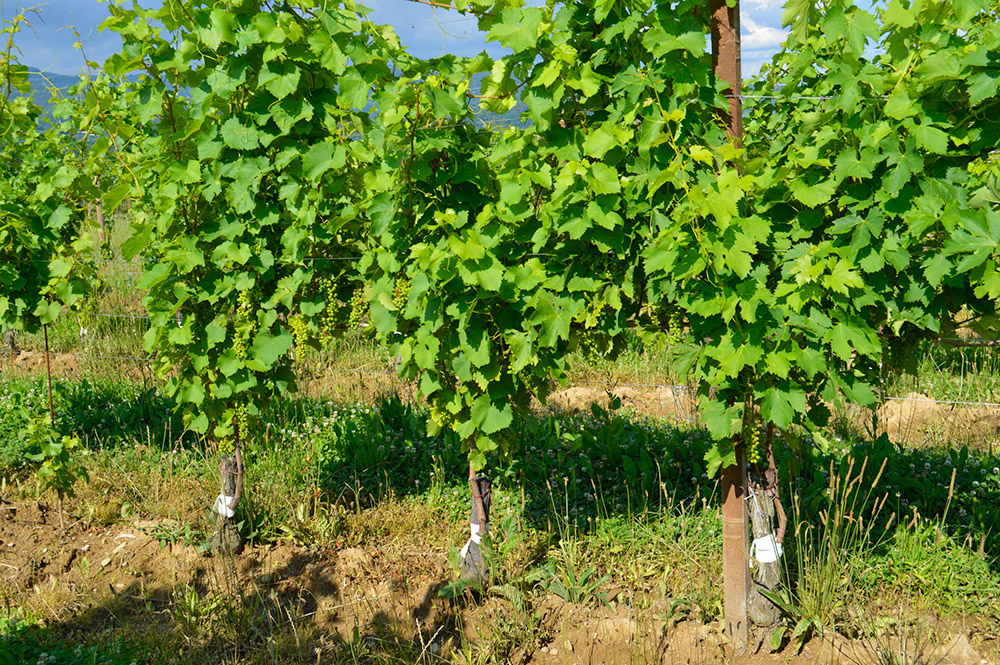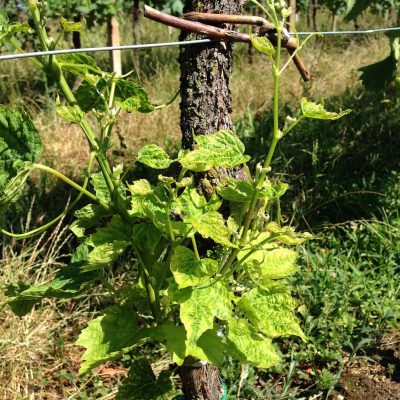VINE GRAFTING
PRELIMINARY ANALYSIS
With double grafting we can shift the company production needs without uprooting the vineyard.
There are substantial benefits, especially in reaching full production by working on adult plants. This happens thanks to an already sturdily built root system, and to a well-maintained support structure (we avoid uprooting it and replanting it).

DOUBLE GRAFTING 13 MONTHS OLD

DOUBLE GRAFTING 15 MONTHS OLD
Before grafting, the winegrower must ascertain the vineyard critical points and analyze the choices that led him to choose double grafting. This is requested since grafting is the most convenient option for the winegrower.

The following examples show how grafting may not provide the desired benefits. The winegrower could then re-evaluate the situation:
- Inapt rootstock for the vine soil
Hydromorphism/drought: not enough strength in high sun-exposure; the grapes receive direct sunlight, which lowers their quality - Plants with disease
Some viruses cause flower abortions; grafting a vineyard with diseased rootstock will generally not produce grapes. Rugose Wood, Black Wood and Flavescence, Virosis, Bacteriosis lower or prevent any chance of grafting - Enological objective
There is not always the same high-quality rootstock used with different varieties - Planting distance
Narrow planting layouts are right for certain varieties whereas for others they lead to a reduction or prevent production
- Cultivation technique used in vineyard management
Under-Row weeding/sprout-inhibiting chemicals lower the chance of grafting - Soil conditions
Hydromorphism must be eliminated since it limits the root system development. A plant with a non-efficient root system responds slower to grafting - Vineyard exposure
Vineyard exposure plays a fundamental role in achieving enological success - Staff employed by the company
The staff in charge or made available to the company must have enough components to take care of the grafts, performing delayed agronomic operations will significantly reduce the chance of grafting
Some of these conditions lower graft success, others prevent satisfying the enological objective.
GRAFTING TECHNIQUES
CLEFT GRAFTING
Cleft grafting is done during the plant re-growth. It consists in uprooting the stem and opening it along the wood fibers. Scions of different varieties are inserted in this fissure. This technique is invasive for the conductive tissue of the plant, since the split stays open for a few years before closing. Also, being the split vertical, it exposes the shaft to water and moisture, creating ideal conditions for the settlement of wood-degenerative mushrooms.

In ancient times this technique was used on rootstocks, as they lack crooked wood fibers and the scions fit perfectly on the rootstock entire surface. Also, by covering the graft with dirt, it was possible to maintain the necessary level of humidity to allow for calluses formation and graft welding.
BUD GRAFTING
The bud grafting is non-invasive for the conductive tissue and is generally preferable to splice grafting.
The two grafting techniques are:
• CHIP-BUD

Chip-Bud grafts are performed at the same time as the wedge graft, during the vegetative recovery. It is precisely because it is performed during this time, when the conductive tissue works at full speed, that it is necessary to pay attention to regulating the upward lymph of lymph, avoiding the so-called “graft drowning”. Since its first year, this technique has shown to endure any kind of stress, being that the bud is wedged into the shaft. When the shaft has a medium/large, non-polygonal section, it is preferable to use a T-Bud insertion.
• T-BUD

The time for the T-Bud is when the vine is in bloom. During this time, the vascular wood changes create the xylem and the phloem, of which the latter easily detaches from the wood. With a T-shaped incision right up to the wood, we will create a pocket, in which the gem of the new variety will be inserted.
The time for the T-Bud is when the vine is in bloom. During this time, the vascular wood changes create the xylem and the phloem, of which the latter easily detaches from the wood. With a T-shaped incision right up to the wood, we will create a pocket, in which the gem of the new variety will be inserted. This technique is easier than the Chip-Bud, however it has to be done correctly in order to guarantee grafting. Whether one uses the first grafting technique in late April, or the second in mid-June, bud development at the end of the season won’t be affected whatsoever. The grafting technique is chosen depending on the graft itself. Both techniques have a high chance of engraftment.
HERBACEOUS GRAFTING

Splice graft on the bud was a widely used technique in the Fascist era. It consists in inserting a scion propped with a splice cut in the sprout developed in that same year. The right time is late May and in any case before the sprout has completely matured. The sprout is chop-trimmed, split longitudinally near a leaf and in this slit the scion is inserted. This type of grafting offers high mechanical resistance.
COLLECTING SCIONWOOD
Harvested buds will always be twice as many as the necessary number. At the time of grafting, their selection is quite rigorous and many can be rejected. Therefore, in single grafting, the number of buds will be double the number of plants to graft, while for double grafting 4 buds will be harvested for each grafted stock.

GENETIC MATERIAL
Another key factor to grafting success lies in wood harvesting and storing. Wood must be harvested from unpruned plants, gathered in bundles of 100 shoots, maintaining the same polarity, and placed as soon as possible in a cold storage at 4° C. To avoid dehydration bundles must be wrapped in newspaper or nonwoven fabric (NWF), moistened and sealed in PVC bags. If scions are taken from farm plots or third parties one must be sure that this material is healthy. This will prevent the spread of diseases or graft postponement due to unsuitable material. Inspection and selection of donor plants should be carried out during the vegetative season preceding grafting when visual selection is much easier. All unsuitable plants must be marked with tape and it is preferable not to collect wood even from those plants adjacent to marked plants although they might appear healthy. When a donor vineyard has a high number of infected plants it is advisable not to collect any material from it. Do not pick up shoots from struggling plants (even if they look healthy) or from vigorous stocks. Correct scion diameter is 8 mm. However, if working on very thin plants, a thinner diameter is preferable.
Label all material before storing it in a cold room.




